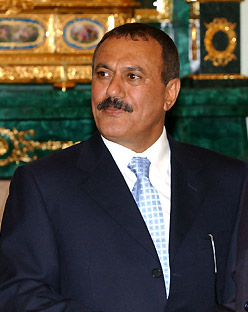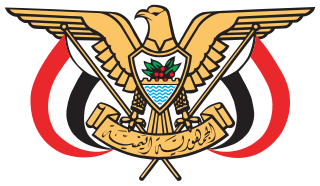
Ali Abdullah Saleh was a Yemeni politician who served as the first President of Yemen, from Yemeni unification on 22 May 1990 to his resignation on 25 February 2012, following the Yemeni Revolution. Previously, he had served as President of the Yemen Arab Republic, or North Yemen, from July 1978 to 22 May 1990, after the assassination of President Ahmad al-Ghashmi.

Yemen, sometimes spelled Yaman, officially the Republic of Yemen, is a country at the southern end of the Arabian Peninsula in Western Asia. It is the second-largest Arab sovereign state in the peninsula, occupying 527,970 square kilometres. The coastline stretches for about 2,000 kilometres. It is bordered by Saudi Arabia to the north, the Red Sea to the west, the Gulf of Aden and Guardafui Channel to the south, and the Arabian Sea and Oman to the east. Yemen's territory encompasses more than 200 islands, including Socotra, one of the largest islands in the Middle East. Yemen is a member of the Arab League, United Nations, Non-Aligned Movement and the Organisation of Islamic Cooperation.

Taiz is a city in southwestern Yemen. It is located in the Yemeni Highlands, near the port city of Mocha on the Red Sea, lying at an elevation of about 1,400 metres (4,600 ft) above sea level. It is the capital of Taiz Governorate. With a population of over 600,000 in 2005, it is the third largest city in Yemen after the capital Sana'a and the southern port city of Aden.

The Yemen Arab Republic, also known as North Yemen or Yemen (Sanaʽa), was a country from 1962 to 1990 in the western part of what is now Yemen. Its capital was at Sanaʽa. It united with the People's Democratic Republic of Yemen, on May 22, 1990, to form the current Republic of Yemen.

South Yemen, officially the People's Democratic Republic of Yemen, was a country that existed from 1967 to 1990 as a state in the Middle East in the southern and eastern provinces of the present-day Republic of Yemen, including the island of Socotra. It was also referred to as Democratic Yemen or Yemen (Aden).

North Yemen is a name given to the Mutawakkilite Kingdom of Yemen (1918–1962) and the Yemen Arab Republic (1962–1990), states that exercised sovereignty over the territory that is now the north-western part of the state of Yemen in southern Arabia.

The Yemen national football team, is the national team of Yemen and is controlled by the Yemen Football Association.

The Yemeni Air Force is the air operations branch of the Yemeni Armed Forces. Numbers of aircraft can not be confirmed but serviceability of these aircraft is low. Aircraft have been acquired by donations from other countries supporting either the Soviet Union or the United States during the Cold War. However, most of the air force was destroyed by airstrikes conducted by the "Arab coalition" consisting mainly of Saudi Arabia and UAE: 2015 military intervention in Yemen.

The Houthi insurgency in Yemen, also known as the Houthi rebellion, Sa'dah War, or Sa'dah conflict, was a military rebellion pitting Zaidi Shia Houthis against the Yemeni military that began in Northern Yemen and has since escalated into a full-scale civil war. The conflict was sparked in 2004 by the government's attempt to arrest Hussein Badreddin al-Houthi, a Zaidi religious leader of the Houthis and a former parliamentarian on whose head the government had placed a $55,000 bounty. Initially, most of the fighting took place in Sa'dah Governorate in northwestern Yemen, but some of the fighting spread to neighbouring governorates Hajjah, 'Amran, al-Jawf and the Saudi province of Jizan. Since 2014 the nature of the insurgency has changed with the Houthi takeover in Yemen and then into the ongoing Yemeni civil war (2015–present) with a major Saudi-led intervention in Yemen beginning in 2015.

Al-Qaeda in the Arabian Peninsula, or AQAP, also known as Ansar al-Sharia in Yemen is a militant Islamist group primarily active in Yemen and Saudi Arabia that is part of the al-Qaeda network. It is considered the most active of al-Qaeda's branches that emerged after the weakening of central leadership. The U.S government believes AQAP to be the most dangerous al-Qaeda branch. The group established an emirate during the 2011 Yemeni Revolution, which waned in power after foreign interventions in the subsequent Yemeni Civil War.

The Houthi movement, officially called Ansar Allah and colloquially simply Houthis, is an Islamic political and armed movement that emerged from Sa'dah in northern Yemen in the 1990s. The movement was called Houthis because its founder is from the Houthi tribe. They are of the Zaidi sect, though the movement reportedly also includes Sunnis. Under the leadership of Hussein Badreddin al-Houthi, the group emerged as an opposition to former Yemeni president Ali Abdullah Saleh, whom they charged with massive financial corruption and criticized for being backed by Saudi Arabia and the United States at the expense of the Yemeni people and Yemen's sovereignty. Resisting Saleh's order for his arrest, Hussein was killed in Sa'dah in 2004 along with a number of his guards by the Yemeni army, sparking the Houthi insurgency in Yemen. Since then, except for a short intervening period, the movement has been led by his brother Abdul-Malik al-Houthi.

The South Yemen insurgency is a term used by the Yemeni government to describe the protests and attacks on government forces in southern Yemen, ongoing since 27 April 2009, on South Yemen's independence day. Although the violence has been blamed on elements within the southern secessionist movement, leaders of the group maintain that their aims of independence are to be achieved through peaceful means, and claim that attacks are from ordinary citizens in response to the government's provocative actions. The insurgency comes amid the Shia insurgency in the country's north as led by the Houthi communities. Southern leaders led a brief, unsuccessful secession in 1994 following unification. Many of them are involved in the present secession movement. Southern separatist insurgents are active mainly in the area of former South Yemen, but also in Ad Dali' Governorate, which was not a part of the independent southern state. They are supported by the United Arab Emirates, even though the UAE is a member of the Saudi Arabian-led coalition working to support the Yemeni government under President Abdrabbuh Mansur Hadi.
The Al-Qaeda insurgency in Yemen refers to the armed conflict that started in 1998 between the Yemeni government with United States assistance, and al-Qaeda-affiliated cells in Yemen. The strife is often categorized as a sub-conflict in the greater Global War on Terror.

Abdrabbuh Mansur Hadi is a Yemeni politician and former Field Marshal of the Yemeni Armed Forces. He was Vice President from 1994 to 2012; and the President of Yemen from 27 February 2012 to 22 January 2015 when he was overthrown by Houthi revolutionaries. He has been retaining the title of 'president' after initially resigning, though he lives in exile in Saudi Arabia.

The Yemeni Uprising (intifada), and also known as the Yemeni Revolution of Dignity followed the initial stages of the Tunisian Revolution and occurred simultaneously with the Egyptian Revolution of 2011 and other Arab Spring protests in the Middle East and North Africa. In its early phase, protests in Yemen were initially against unemployment, economic conditions and corruption, as well as against the government's proposals to modify Yemen's constitution. The protesters' demands then escalated to calls for the resignation of Yemeni President Ali Abdullah Saleh. Mass defections from the military, as well as from Saleh's government, effectively rendered much of the country outside of the government's control, and protesters vowed to defy its authority.

Visitors to Yemen must obtain a visa from one of the Yemeni diplomatic missions unless they come from one of the visa countries whose citizens may obtain visa on arrival. Until January 2010 Yemen had a visa on arrival policy for some 50 nations.

The Yemenite War of 1979 was a short military conflict between the Yemen Arab Republic and the People's Democratic Republic of Yemen. The war developed out of a breakdown in relations between the two countries after the president of North Yemen, Ahmad al-Ghashmi, was killed on 24 June 1978 and Salim Rubai Ali, a moderate Marxist who had been working on a proposed merger between the two Yemens, was murdered two days later. The hostility of the rhetoric from the new leadership of both countries escalated, leading to small scale border fighting, which then in turn escalated into a full blown war in February 1979. North Yemen appeared on the edge of a decisive defeat after a three-front invasion by South Yemeni combined arms formation, however this was prevented by a successful mediation in the form of the Kuwait Agreement of 1979, which resulted in Arab League forces being deployed to patrol the North-South border. An agreement to unite both countries was also signed, although was not implemented.

The Yemeni Crisis began with the 2011–12 revolution against President Ali Abdullah Saleh, who had led Yemen for more than three decades. After Saleh left office in early 2012 as part of a mediated agreement between the Yemeni government and opposition groups, the government led by Saleh's former vice president, Abdrabbuh Mansur Hadi, struggled to unite the fractious political landscape of the country and fend off threats both from Al-Qaeda in the Arabian Peninsula and Houthi militants that had been waging a protracted insurgency in the north for years. In 2014, Houthi fighters swept into the capital of Sana'a and forced Hadi to negotiate a "unity government" with other political factions. The rebels continued to apply pressure on the weakened government until, after his presidential palace and private residence came under attack from the militant group, Hadi resigned along with his ministers in January 2015. The following month, the Houthis declared themselves in control of the government, dissolving Parliament and installing an interim Revolutionary Committee led by Mohammed Ali al-Houthi, a cousin of Houthi leader Abdul-Malik al-Houthi. However, Hadi escaped to Aden, where he declared that he remains Yemen's legitimate president, proclaimed the country's temporary capital, and called on loyal government officials and members of the military to rally to him. On 27 March 2015, BBC reported that Hadi had "fled rebel forces in the city of Aden" and subsequently "arrived in Saudi Arabia's capital Riyadh" as "Saudi authorities began air strikes in Yemen". Civil war subsequently erupted between Hadi's government and the Houthis. Since 2017 the separatist Southern Transitional Council (STC) has also fought against the government.

The Yemeni Civil War is an ongoing conflict that began in 2015 between two factions: the Abdrabbuh Mansur Hadi led Yemeni government and the Houthi armed movement, along with their supporters and allies. Both claim to constitute the official government of Yemen.

The Saudi-led intervention in Yemen, also called the Arab coalition, is an intervention launched by Saudi Arabia in 2015, leading a coalition of nine countries from West Asia and Africa, in response to calls from the internationally recognized pro-Saudi president of Yemen Abdrabbuh Mansur Hadi for military support after he was ousted by the Houthi movement due to economic and political grievances, and fled to Saudi Arabia.















